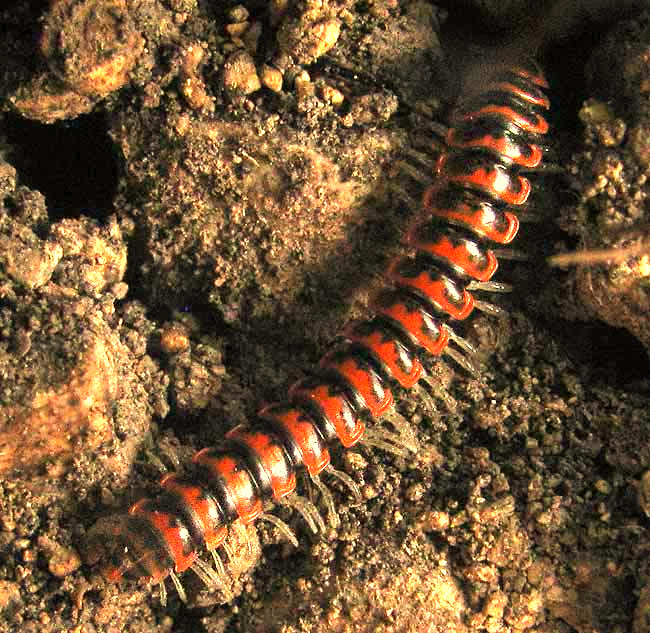Excerpts from Jim Conrad's
Naturalist Newsletter

from the January 12, 2014 Newsletter issued from the Frio Canyon Nature Education Center in the valley of the Dry Frio River in northern Uvalde County, southwestern Texas, on the southern border of the Edwards Plateau; elevation ~1750m (~5750 ft); N29.62°, W99.86°; USA
EURYMERODESMUS MILLIPEDE
Here even in winter if a decently warm day comes along you might spot an inch-long (3cm), orange-and-black millipede slowly foraging in shadowy zones beneath tree roots and outcropping bedrock, like the one shown above.
At first I thought that this was a centipede because many millipedes have a greater number of body segments and their legs are less robust. However, you can see that on our critter each body segment bears four legs -- two pairs -- so it's a member of the Arthropod class Diplopoda (millipedes) instead of the class Chilopoda (centipedes), which bear only two legs per segment.
It's worthwhile to notice whether you have a centipede or millipede because centipedes normally are predators bearing a pair of venom claws or "forcipules" with which prey can be incapacitated, and which sometimes can execute painful bites to people. In contrast, most millipede species are peaceful, slow-moving vegetarians eating decaying leaves and other dead plant matter -- they're "detritivores." Some millipede species, however, can damage emergent seedlings, especially in greenhouses. Many millipedes have pores along their bodies that can emit hydrocyanide, formic acid and other irritants as a defense against predators. Most species release the liquid slowly, but some can discharge it as a spray.
Volunteer Bea in Ontario figured that our orange-and-black millipede was a member of the Family Eurymerodesmidae. Since that family contains only the genus Eurymerodesmus, we must have a Eurymerodesmus millipede. Rowland Shelley's 1989 work entitled "Revision of the millipede family Eurymerodesmidae (Polydesmida: Chelodesmidea)" can be downloaded for free from the Internet at https://www.biodiversitylibrary.org/part/49963#/summary.
That work describes Eurymerodesmids as "the dominant polydesmoid diplopod in prairie ecosystems, ranging westward onto the Edwards Plateau... " and of course the Edwards Plateau is where we are. The word "polydesmoid" refers to the Polydesmida, the largest order of millipedes with about 2,700 known species worldwide. Polydesmid millipedes are recognized in the field by having between 18 and 21 segments with each segment bearing wing-like projections, clearly visible in our photo, giving the millipede a flattish appearance.
With Shelley's paper and some dissection probably we could have identified our critter to species level, but I prefer having an intact unnamed millipede to a dissected one with a name.
Eurymerodesmus millipedes occur from southeastern Nebraska and southern Illinois south and eastward along the Gulf Coast Plain to southeastern North Carolina, and into Mexico.